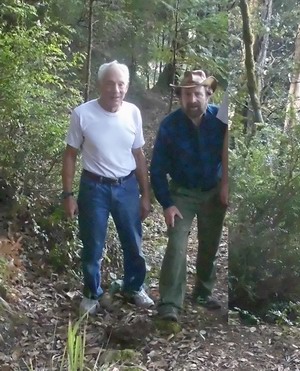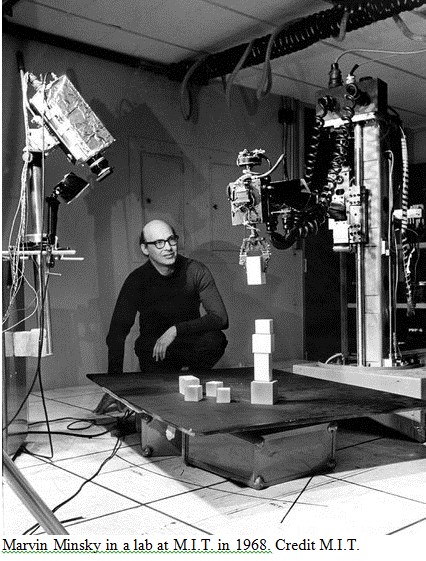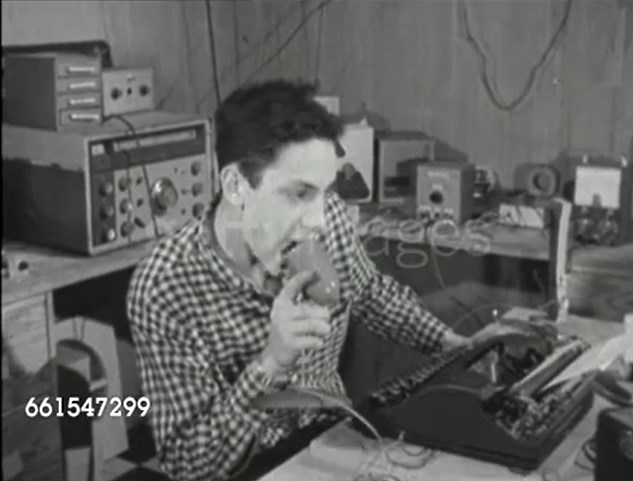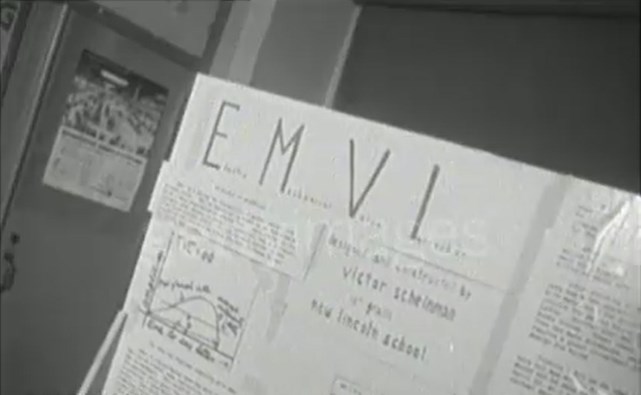
October 2015 at Petrolia: Vic and HAC My friend of many years, Victor Scheinman died of a heart attack, September 20, 2016. His death occurred at Petrolia in Norther California. Just 11 months before I had travelled with Vic from San Francisco to Petrolia, to catch up with his brother Ric. While at Petrolia we were partners in a ride and run relay race, from Petrolia town centre to the sea: we took turns - one running, while the other rode - a tough optimization problem. (We came last - largely because at a critical stage I did see the bike discarded by Vic while he commenced running - and so ranfar too far before I realised this - and walked back to the bike - to finally caught up with Vic near the finish. ) Encounters with Vic After compleing his undergraduate work at MIT, Vic travelled the world for many months. In New Zealand he met my cousin (once removed) Robert Bear, who suggested to Vic that in Sydney Vic could stay with Robert's parents, and in Canberra with me, where I was a PhD student at the ANU. So sometime in 1963 Vic just turned up unannounced at Canberra - and I gave him accommodation, and drove him around Canberra. But in a classic car -- a 1949 Citroen L15 -- whose mechanical petrol pump was not working -- but by means of a wire though the dash I could pump petrol into the carby. We gelled. After all, I was the student of theoretical physics who was at home in the physics workshop, and had turned on a lathe brass gearbox bushes - a little bit of practical engineering. After our initial encounter For a few years we exchanged the occassional letter or card - but then - in those pre-email days -- correspondence ceased. Meanwhile here in Oz -- on completing my PhD in QED, and a four year stint (1966-1969) as a post-doc in Mathematical Physics at the University of Adelaide -- in 1970 I took up a lectureship (in Mathematics at La Trobe University -- where in teaching mechanics became concerned about students understanding of qualitative physics -- conducted research leading to my production of puzzles in qualitative physics -- which are analogous to the conservation puzzles invented by Piaget and his co-workers in assessing the child's intellectual growth (ëpistemology"). This collection of qualitative physics puzzles -- called Dragons -- was published in 1974 and rather lavishly illustrated -- and lead to an invitation by Seymour Papert to spend much of 1974 with the LOGO Group at the MIT AI Lab. During my time at MIT in 1974 -- there was a short break -- and I went off to the west coast visit XEROX PARC and the Stanford AI Lab (SAIL) both in Coyote Hill Road, Palo Alto. In the Stanford AI Lab I found "V. Scheinman" label on a door -- and rapidly met up with Vic again. At this stage -- while technically still a PhD student at Stanford -- Vic was running his robot "factory" - VICARM - in a small hired garage in Palo Alto -- with just one employee - a machinist -working one or two days per week -- plus students contracted to code an Vic's arm control language (VAL). Vicarm was supplying Vic's MIT or Stanford Arms to research labs around the world. Either then -- or about a year later when I passed through SF enroute to a Loud Thinking Conference at MIT -- I had a session one night with Vic when he (and to a lesser extent I) discussed the qualitative physics reasons why planes fly. Not just the classic text book stuff showing laminar flow past an aircraft wing. We came up with ten different qualitative explanations.  Vic Schenman and Harvey Cohen, San Francisco, 2006 |
Victor Scheinman My
Man in the Smithsonian What makes a man a pioneering inventor? Schooling? Vic went to the New Lincoln School - in New York. This school had been founded by Columbia Univerity, where Vic's father was a professor of psychiatry. The school is now defunct, but Wiki lists its meritorious alumni: these are artists, performers, politicians, but no engineers or scientists except Vic.(*) Influence of his father? Every Saturday morning while enroute to his practise Vic's Dad dropped him off -- not at barmitzvah classes -- but to spend time with Adam Hersell of European background - a professional glassblower -- who produced technical glassware for science laboratories. Together they did many mini- in science cum engineering miniprojects. One such mini-projectis indicative: It involved making an incandescent lamp from a fluorescent tube - through an understanding of the design of the tube. At one end of a fluorescent tube is a filament -- that the unit's "starter" switches off a short time after the tube is switched on. In normal operation the hot filament prides the ions necessary for the light to 'strike'. Vic and his mentor cut off the filament end of such a fluoro tube -- removed the phosphor coating -- and sealed it off with glassblowing techniques. Now they had an incandescent light -- which worked OK for less than 50 volts -- although as the sealed short tube contained air the filament would ultimately burn out. Notice how Vic used a deep knowledge of the device to effect a radical redesign. Childhood hobbies? Vic was a ham radio operator from early in his teens. This gave Vic a basic knowledge of electronics - which was certainly essential to the design of his voice actuated typewriter - next described. THE (teenage) Project Somehow while only 15 years old, Vic conceived of making a voice controlled typewriter. For this purpose he adapted electromagnets to actuate the keys of a manual typewriter. The user spoke into a microphone, and the signal was classified (as A, B, C, ... etc) by analogue circuity. This was in 1959 (check year). Understandably -- this project won for Vic a Science Prize -- and entry into MIT. [ I wonder how many other -- if any --Lincoln School students "made it" into MIT ] In discussions I once had with Vic he reported the (analogue) algorithms he devised were in fact essentially the same as were then being developed in the early AI Labs. Development of Self-Assertiveness Vic had entered MIT intent of working in avionics -- possibly in rocketry. However after he returned to MIT to further this direction Marvin Minsky offered him support to construct a robot arm for simple manipulations. At this point in time, Terry Winograd and other of Minsky's students were developing "Blocksworld" concepts, wherein a computer could understand simple commands like "Put the Red Block on top of the Blue Block" to make simple structures akin to those a young child makes of such blocks. With the robot arm Vic developed realistic demonstrations could be realised. But Minsky did not see the potential of Vic's first arm for industrial production -- and its further development was not written into the MIT AI Labs funding proposals. Vic then followed a key advisor to Stanford. At this stage he had a definite project in his mind - and tried to organise this as the development of an arm for Stanford AI Lab -- while he was pursuing a PhD. But -- with his basic studies in avionics -- he found a lack of interest in the Stanford Aeronautics Department in supervising HIS Project -- but Stanford Mechanics Engineering were more flexible -- so that it was in Mech Eng that he was formally enrolled -- though naturally he shared a student office in SAIL. Thus he came to develop what is called the Stanford Arm -- where in place of a shoulder-like joint -- an extendible arm was guided through a prismatic joint. [ This was an alternate scheme offering a large working volume for the actuators on the (far) end of the arm. When I first went into SAIL in 1974 I found Vic's Stanford Arm being employed in the assembly of an automobile water pump -- a realistic engineering production task -- not as in MIT where only Blocksworld challenges were posed. | |
MIT AI Lab robot BEFORE Vic The rather junky robot of limited capability stacking a Blocks World whose inadequacies lead to funding of Vic to construct the anthropomorphic arm that included an analogue elbow - what is now called his MIT Arm |
The Science Fair Project
 16 year-old Vic operating his EMVI = Electro Mechnical Voice Input typewriter plus the EMVI poster with a speech phoneme graphs related to the band-pass filters he used. | |
(*) NOTABLE ALUMNI of New Lincoln School NY
From Wiki: https://en.wikipedia.org/wiki/New_Lincoln_School
- Minnijean Brown of the Little Rock Nine[6]
- Shirley Clarke, filmmaker[7]
- Thelma Golden, curator[8]
- Adrian Piper, artist[9]
- David Rockefeller
- Victor Scheinman, robotic pioneer[10]
- Michele Wallace, author and professor[11]
|
Stockholm 2013 | Jack Smith -- Peter Higgs first student -- my friend and one-time collaborator. A Memoir | |
|
|
Victor Scheinman
my long-term friend
The inventor of the assembly line robot. His PUMA Robot in the Smithsonian. What made this man ? | |
|
The only woman ionospheric physicist and the only Australian involved in the design of US Air Force SatNav system later renamed GPS. |
Elizabeth Essex-Cohen -- my future wife was in the
USAF Geophysical Research Lab 1974 playing a vital role in GPS system design by applying known ionosphere structure to check out putative orbits for GPS satellites. But this GPS pioneer hit the glass ceiling at La Trobe University in 1983: forbidden by her professor to supply me TEC data scans from passes of orbiting beacon satellites for computation in real-time of ionospheric tomography by methods adapted from medical tomography. Late Career highs as Program Chair for Conf. WARS 2000 (Wireless Applications of Radio Science) and as lead researcher and GPS research head for FedSat Australian scientific satellite launched 2002. Nevertheless a long career in space science as married woman so unlike the experience of Ruby Payne Scott also born in Grafton, NSW. | |